Finally the time has come! After breeding, caring for your pregnant doe while waiting a long 145-155 ish days, and recognizing the signs of labor, it’s time to give birth! So, what do you do when goat kids are born?
There are certainly many, many different scenarios that can arise. Kids can need to be re-positioned due to presenting improperly, perhaps need to be pulled, not be breathing when born, etc, etc. This is life being born after all, so many things can go wrong. Way too many to mention. This post is not about everything that can go wrong and how to handle it. What it is about however, is what do you do when goat kids are born to get them off to the best start possible. And let’s not forget those precious does! They need some post birthing love too. So, grab your kidding kit and let’s get to it!
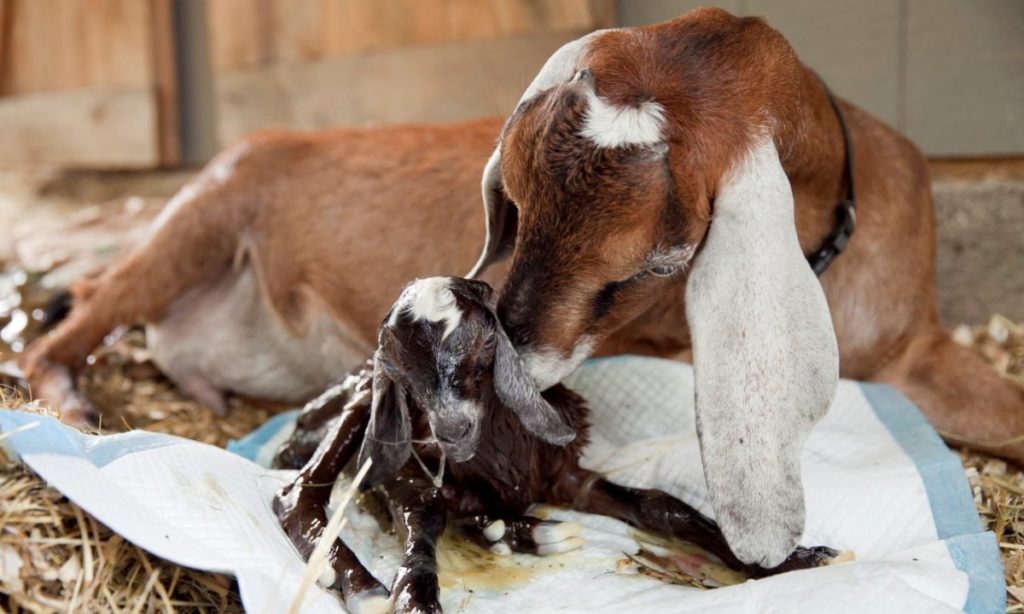
The Kids
Okay, so the kid(s) are born and have officially hit the ground! First, let’s see what a textbook birth looks like. By textbook I mean the kid has presented in the diving position with the front legs forward, with the head tucked between. This would be as opposed to breached (butt first), sideways, etc. She didn’t get stuck, Audrey didn’t struggle, she just slid right out and plopped onto the puppy pad.
Excuse the darkness, it was 5 am afterall…
Immediately After Birth
Once those kids hit the ground you want to make sure they are free from their sac (if it didn’t break) so they don’t drown in their own fluid. Next, you want to make sure their nose and mouth are clear of mucus so they can breathe. Some people use a nose sucker, but for me this is just one more “thing” to lose track of and fumble for in the dark. So, I use my good ole’ fingers to pull away mucus from the nose and scoop it out of the mouth if needed. If it’s really packed in there and you can’t get it cleared, grab the kid by the back legs and let it dangle upside down gently swinging. With the help of gravity, the kid sneezing, and your hands, this will help the mucus clear from the nasal passage.
After the nasal passage has been cleared, give that kid to mama. Let her clean it up! Not only does this cleaning stimulate the kid and help perk it up, it aids in bonding. Unless it is absolutely freezing and I need to get those kids dry stat, I do not rush this process. Drying them off yourself is 100% a matter of the weather and temperature. I have had kids born in March thru June. One of the perks of warmer weather kidding is of course you don’t have to worry about them being wet and cold. In these cases I have let mom clean them off and they air dry without issue. In cold winter temperatures however, human intervention is needed. Dry them off with a hair dryer after mom has cleaned them off a bit, and remember you want to get them bone dry.
Next you need to give each kid a little TLC with some nutrients and umbilical cord treatment. In your kidding kit you should have Nutridrench and Iodine. Give that bottle of Nutridrench a good shake, and give each kid two pumps in their mouth. As for the umbilical cords, depending on where they detached when being born you may want to give them a trim. You don’t want them so long they’re stepping on them, a couple of inches is sufficient.
You can either dip the cords in the iodine, or spray. To dip, fill a shot glass or some other small shallow vesicle with iodine. Hold the kid, and dip the cord up the the belly. You want to get it all the way up to the belly. To spray, simply douse the cord to where it meets the belly with the iodine fitted with a spray bottle. Dipping/ spraying with iodine prevents the risk of a naval infection, which can become serious. This is a simple preventative step, and don’t worry you can’t use too much iodine!
soon after birth
Once your kids are dry, dipped, and drenched it is imperative they get colostrum. Colostrum is what the mother is producing first after birth as opposed to milk. It’s a thick, power punch of nutrients, and most importantly it’s full of antibodies. Kids are born without any immune system, so the antibodies the mother passes on in the colostrum are essential for life.
While I cannot attest to the exact timeline that a kid needs to have colostrum or it will die (spoiler there is no “magic” number). You do want to make sure they get that first drink as soon as possible. My target is always within an hour from birth, although I know many shoot for within 2-3 hours.
Depending on how strong and determined the kid(s) is, as well as how receptive your doe is to nursing, this may require your assistance. It may also require some serious patience. Newborn kids can be quite fumbly, and seem to be able to get the teat everywhere except in their mouth. Help direct the kid to the udder, and if need be direct the teat toward their mouth to help them latch. Hold them to help them stand if need be. If mom is being difficult and isn’t taking to it, rub her flank and speak softly to her. Sometimes kids are up and immediately looking to nurse and have no problems, others struggle. Some moms are naturals, others don’t know what they’re supposed to do and need help from you to show them the way.
If need be, put mom on the milk stand to distract her with grain and restrain her. Put the kid on the stand with her and try the process again. It can be extremely frustrating, but patience is key. Stressing will create stress for her, and won’t help the situation. Once you get a successful latch and everyone figures out “this is what they’re supposed to do” the hard part is (usually) over. Just like the cleaning, nursing is a crucial part of bonding between doe and kids. She will get a flood of hormones that solidify her bond with her babies, and instincts will kick in. There are of course exceptions to the rule, and some goats are just bad moms. But generally speaking, this is the norm.
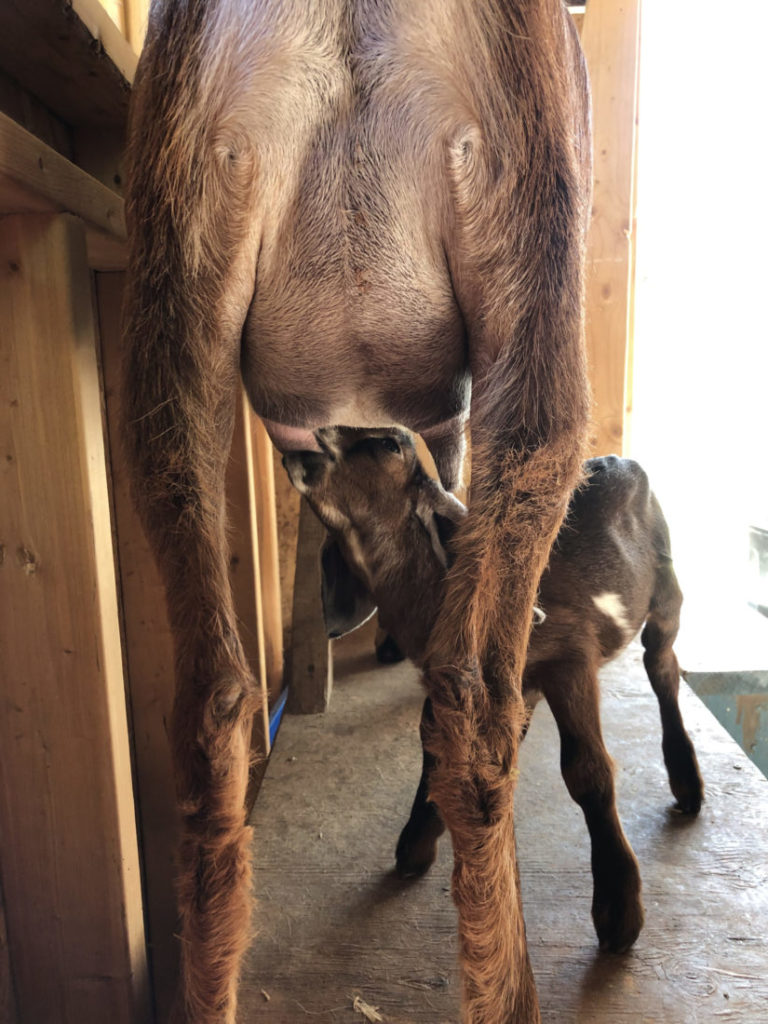
over the next 24 hours
Like with any newborn animal, you want to monitor them as well as mom over the next 24 hours. Depending on the weather, additional measures may need to be taken to keep the kids warm. They also need to be nursing every 2 hours, so regularly check in on them to make sure that you are seeing them latch on. They still may need some help finding the teat and latching, so it’s good to keep an eye on them.
You will also notice meconium poop for the first day or so. A black, tar-like poop that should be getting cleaned by mom. If she isn’t, regularly clean it off with a damp cloth/baby wipe to prevent blockage. As the kid nurses, the colostrum acts as a laxative and helps push the meconium through their system where it will then change to a runnier and yellowish tinted colostrum poop.
General awareness and the power of observation is not something to disregard. You don’t have to be a “seasoned” breeder to recognize that something may be amiss. If a kid looks lethargic and weak, something is likely going on. Trust your instinct, and intervene if you feel the situation calls for it.
The Doe
Now that we have gotten the kids squared away, it’s time to turn our attention to those mamas. I cannot emphasize how much easier a good mother makes things on you. I also can’t emphasize enough the importance of giving your doe the absolute best care and nutrition so that she in turn can take proper care of her kids.
Immediately After Birth
Once all of the kids have been born, she will soon begin to pass the afterbirth. Whatever you do, DON’T TOUCH IT! Don’t pop it, try to pull it out, etc. Let it hang and release on its own. Sure, it may look gross and you may have to avoid getting whacked with it as she moves around with it dangling out of her backside. But, it will release on its own. Selenium aids in the release of the placenta, and the regimen I follow when caring for a pregnant doe is specifically designed with this scenario in mind. It can happen within 10 minutes of giving birth, or it can take a few hours. But, whatever you do, resist the urge to mess with it.
Just like you gave the babies some nutridrench after being born, you will want to give your doe a couple of pumps as well. It has many essential vitamins and minerals (including selenium) that will help perk her up, release the placenta, and give her the energy to care for her babies. In addition to this, I also offer fresh warm water with a little bit of molasses added for a sugar boost and to encourage her to drink, as well as plenty of grain with pregnancy tonic mixed in.
soon after birth
Don’t be surprised if your doe is not interested in eating immediately and may be preoccupied with her babies. But, you do want to make sure she eats and drinks as soon as possible afterwards. She needs calories and water for energy and to make milk for her kids.
You also want to keep an eye on her to make absolutely sure that she passes and releases her placenta. Animals will eat it (and I encourage such behavior) so you can’t always rely on being able to find it. If the placenta doesn’t detach and release but is retained, this can cause a serious infection if left un-diagnosed and treated.
Another thing to keep an eye on is your doe’s udder. Check to make sure the teats aren’t block and milk is flowing properly, as well as for any signs of mastitis (redness, hard and hot to the touch) in the udder. Keep an eye on her, and generally observe her behavior for anything that could indicate that there is an infection, milk fever, etc. Early detection is critical.
over the next 24 hours
Over the next 24 hours and beyond, you are going to do a lot of observing. Continue to check to make milk is flowing and there are no signs of mastitis. Make sure she’s eating, drinking, and appears to be in general good health. Her body will continue to flush out even over a week after kidding, so blood and brownish discharge is normal. I continue to feed out the pregnancy tonic up to two weeks after kidding as this helps reduce the postpartum bleeding.
Towards the end of the first day after kidding, I always milk out some colostrum for the freezer. This is a very good thing to keep on hand for future kiddings or even if you breed pigs and sheep. Some goats’ milk is delayed coming in, or god forbid if something happens to your doe during labor it’s even more critical. Colostrum from the first 24 hours as well as at least a gallon of milk is something that I always keep in my freezer just in case. I have never had to use it yet, but it’s comforting that it’s there if a situation arises.
Deworming immediately after kidding is common practice. After labor, your doe is in a vulnerable position to be overrun with a parasite load. If neglected, it can and will get out of control and can create serious adverse health affects. Most dewormers require an initial dose to handle adult/larval stage. Then, a follow up dose x number of days after the initial, to kill the secondary load that matured from the eggs the initial dose didn’t handle. There are many types of dewormers that are specific to different types of parasites. Most are approved for use during pregnancy, and others aren’t. Some people will time it to give the initial dewormer dose during late stages of pregnancy, with the second dose occurring right after kidding. Others will do both doses after kidding. Talk to your vet and see what protocol they recommend for you, but it’s best to be prepared ahead of time.
Every kidding can bring certain challenges. Sometimes things just plain go wrong no matter how much you’re prepared or have done everything you possible could. Like I sad before, these are live animals we are dealing with, expect the unexpected. But, don’t underestimate the power of being an observant steward to your animals. Even though it takes no experience or training, it is something that shouldn’t be disregarded.
Be prepared, have a plan, and trust your gut. Hopefully you feel a little more knowledgeable now about what to do when goat kids are born.
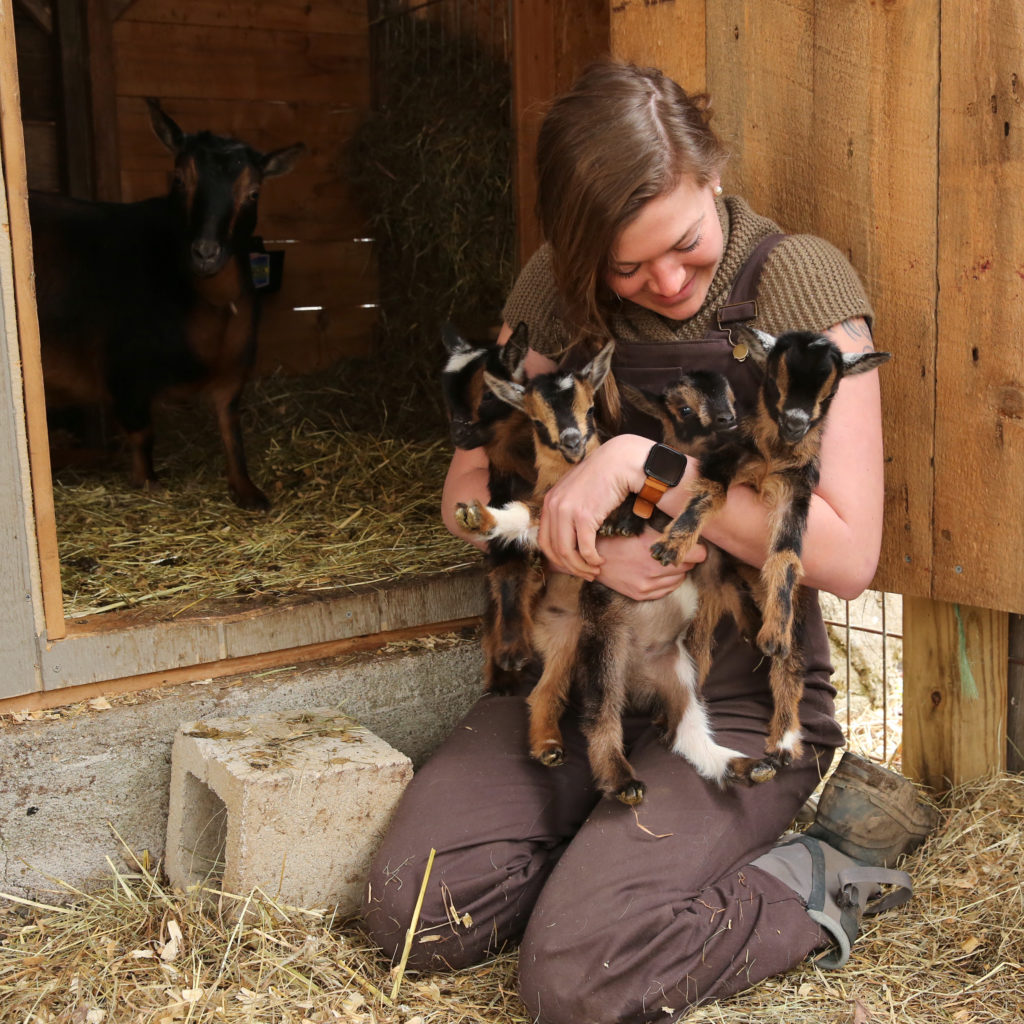
Happy Kidding,

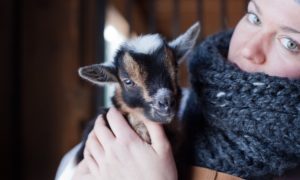
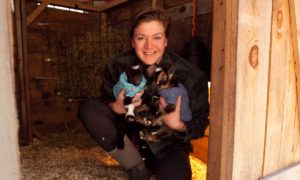

So helpful! I’ve been relying heavily on your blog the last 2 days. We had our very first kidding and this his been extremely helpful! Thank you
That’s what I like to hear! Glad to hear I was of some help, and hopefully you had a successful kidding!
I am so glad I found your page here. We are first time goat owners…we have 4 does and 2 bucks and all the does are pregnant. One is a maiden and has the most signs of kidding first…I am trying to read, look at pictures and watch everything I can…we are looking at earliest Feb. 10th to mid month. I have everything in my “kit” and hubs built some kidding stalls…thanks for all the information you provide!
Sounds like you are as prepared as you can be! Best of luck!!! 🙂
Very nice and well put.
Thanks
Great, clear information. Question: How long should kids be quarantined? And, when quarantining kids from the rest of the livestock, does mama quarantine with them? I would imagine yes, but my doe doesn’t seem very happy about this!
I would only keep dam and kids separated for 24, maybe 48 hours depending on the dynamics of the rest of the herd